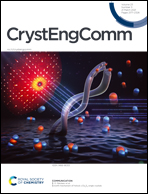Cubic ZnP2 nanowire growth catalysed by bismuth†
Abstract
Zn3P2 and ZnP2 nanowires were grown by physical vapour transport using a bismuth catalyst. Bismuth with a low surface energy and melting temperature is an ideal catalyst for the growth of Zn–P binary nanowires. The ZnP2 nanowires were synthesized using a Zn3P2 source with extra phosphorus vapour supplied from a separate phosphorus source. The Zn3P2 nanowires had a conventional α-Zn3P2 tetragonal crystal structure. Surprisingly, the ZnP2 nanowires had a cubic γ-ZnP2 structure, which is known to be stable only at pressures higher than 1.5 GPa, and its existence is a matter of debate. We observed that Bi catalyst was the deterministic parameter for the formation of γ-ZnP2. The lattice constants (a = 0.53578 nm) of the nanowires were determined from their d-spacing. Unlike the α-Zn3P2 nanowires, the γ-ZnP2 nanowires showed a Raman band (430–470 cm−1) because of the internal vibrations of infinite phosphorus chains. From the contact angle analysis, the growth of the γ-ZnP2 nanowires when catalysed by bismuth, was dominated by centre nucleation rather than triple phase boundary nucleation. A nucleus with smaller dimensions is energetically favorable for centre nucleation, and the γ-ZnP2 nucleus formed during the initial stage of nucleation resulted in the formation of the cubic γ-ZnP2 nanowires. The centre nucleation model may explain the stability of γ-ZnP2 phase even at the synthesis pressure (100–600 Torr).

- This article is part of the themed collection: Crystal Growth


 Please wait while we load your content...
Please wait while we load your content...